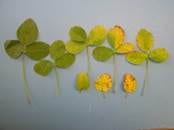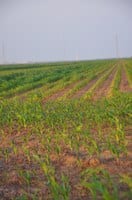Hello,
Rainfall has continued to be the pattern as the growing season progresses. Now the concern also shifts to wheat harvest. Continued rain can have an undesirable effect on wheat grain quality and test weight. Although our wheat is past flowering when Fusarium Head Blight first appears, I have attached an article about why this disease is so common with today’s crop production practices. This article was written by Ed Lentz earlier this month and compliments the agronomy articles that I have included on the subject in these newsletter updates.
I have also attached the May 2015 Rainfall Summary to this email. For the time period of May 1-May 31, Extension rainfall reporters recorded an average of 3.70 inches of rain in Hardin County. Last year, the average rainfall for the same time period was 3.51 inches. Rainfall for May 1-May 31, 2015 matches the 3.70 inches for the ten year average rainfall during the same dates. We will soon be receiving June’s township rainfall reports and those will tell a different story.
The Kenton Times is once again looking for a farmer with a tall corn crop to photograph and publish in advance of the Fourth of July. If you have tall corn or know of someone with a tall crop, please let Tim Thomas know. You can call him at 419-674-4066, ext. 232 or email him at tthomas@kentontimes.com. The latest day they can take the picture is Thursday, July 2. This is an annual tradition that this local newspaper has been doing for several years, so any help you can provide would be appreciated.
I continue to wait for suitable weather and field conditions to do some plot work. I have received a GreenSeeker handheld crop sensor to use to measure the health and vigor of crops. This instrument is used to make objective decisions regarding the amount of fertilizer needed by a crop. The plan is to use it in the two county Corn Response to Nitrogen plots to collect data and compare the results with the amounts of nitrogen that were applied in each test area of the plots. Readings will be taken at different growth stages and will compliment other lab testing procedures.
Below are some agronomy related articles that you might find useful.
Mark
Rootworm Hatch is Underway – Andy Michel
Larry Bledsoe from Purdue University reported that corn rootworm hatch occurred on June 3 (see http://extension.entm.purdue.edu/pestcrop/2015/Issue11/). With the exception of 2012, this seems to be in line with past few years. The bad news is that these young larvae will start to munch on the developing corn roots. The good news is that the heavy recent rain we are receiving will help saturate the soils. This heavy moisture will tend to increase mortality of these very small larvae. How much mortality remains to be seen, and, although this can severely impact rootworm populations, feeding can still be observed. There are good management tools to protect against rootworm feeding, including transgenic hybrids. As most are aware of, rootworm resistance to some Bt proteins has occurred in parts of the Western corn belt. We have not seen any substantial evidence of resistance in Ohio. Regardless of your rootworm management tactic, it is always a good idea to dig roots later in July after larvae development is complete to determine how well the product performed.
Western ARS Agronomy Field Day, July 15th – Harold Watters
The Western ARS Agronomy Field Day will be held July 15, 20015, with registration at 8:30AM until 9, then end the day at 3PM. The farm is located at 7721 South Charleston Pike, South Charleston, Ohio. The Western Agricultural Research Station is the University research center for agronomy in western Ohio. This site carries a significant load of work on soils and conditions that closely resemble much of western Ohio cropping systems. Join us to learn how to improve conditions on your farm. For more information about this annual field day, go to http://corn.osu.edu/newsletters/2015/2015-17/western-ars-agronomy-field-day-july-15th. Pre-registration is requested by July 10th to get a count for lunch from Rudy’s BBQ, the cost is $20 per person payable at the door. Contact Harold Watters Extension Field Specialist at 937-599-4227, watters.35@osu.edu or Joe Davlin Western farm manager at 937-462-8016, davlin.1@osu.edu to register.
Fungicide Options for Soybeans – Anne Dorrance
I looked at the soybean prices on Sunday – all were still less than $10/Bushel. This price combined with yield losses due to late planting, extra expenses for additional late weed control, and flood injury really put the kibosh on all but the most guaranteed return on investment for the remainder of 2015. Foliar pathogens have the most impact on soybeans at the later growth stages (R3 to R6) by reducing the photosynthetic area of the leaves that contribute to pod development and seed growth. Soybeans also have an uncanny ability to compensate for missing neighbors. The profitability measure for the 2015 season will be to scout for the occurrence of diseases after flowering R3 and choose the best fungicide if necessary. Go to http://corn.osu.edu/newsletters/2015/2015-18/fungicide-options-soybeans to continue reading this article.
Wet Weather and Weed Management – Mark Loux
Wet weather has delayed POST herbicide applications in both corn and soybeans. This can result in weeds and crops that are larger and more advanced in growth stage than anticipated. The larger crop is primarily a problem in corn, where a more advanced growth stage can start to limit herbicide options. Be sure to check labels and the OH/IN/IL Weed Control Guide for information on maximum crop size and stage for herbicides. Larger weeds may require higher rates or more complex POST herbicide mixtures. Click on http://corn.osu.edu/newsletters/2015/2015-18/wet-weather-and-weed-management for more information on controlling weeds that are larger and further along in their growth stages.
Be Patient with Wet Hay Fields – Mark Sulc
I know many hay producers reading this article are frustrated by the rainy weather. They know that forage quality is declining with each day that goes by (and why did I have to state the obvious, right?). However, I want to urge hay producers to change their focus and be patient, to make sure their hayfields are dry enough to support their equipment before they try to get out on them once the sun starts to shine again. The loss of quality in one cutting, even the complete loss of the value of one cutting, is less than ruining a forage stand for the remainder of its productive life by running equipment on ground that is still too soft, especially if it is a younger stand. So do what is really easy for me to say, but super hard to practice right now – just be patient. Take the long look and wait until the field is dry enough to support the equipment without damaging the forage stand. Go to http://corn.osu.edu/newsletters/2015/2015-18/be-patient-with-wet-hay-fields to read more.
Mark A. Badertscher
Agriculture and Natural Resources Educator
OSU Extension Hardin County
1021 W. Lima Street, Suite 103, Kenton, OH 43326
419-674-2297 Office





